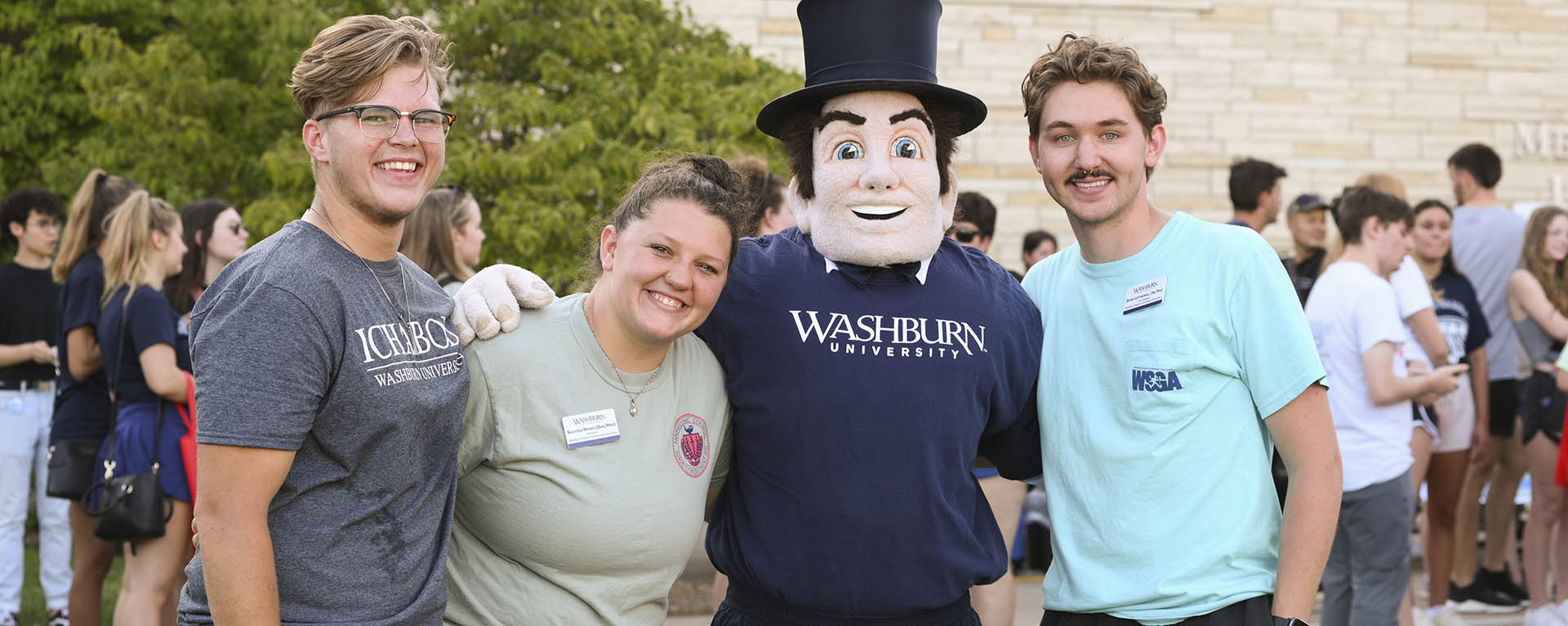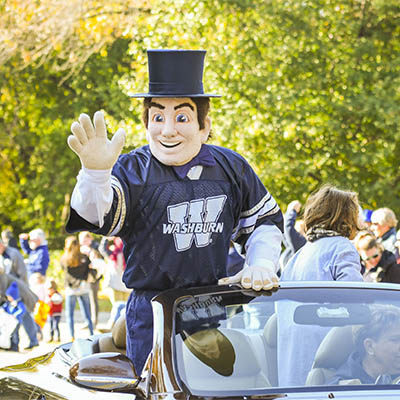

Ichabod mascot
Washburn University and its Ichabods are both named for an early benefactor of the school – Ichabod Washburn. Washburn students began referring to themselves as Ichabods in the late 1800s and a mascot was given an image in 1938.
Washburn’s Ichabod has no connection to
- *Ichabod Crane, a principal character of Washington Irving’s “Sleepy Hollow”
- *The similarly-attired Planter’s Peanuts Mr. Peanut
The real Ichabod Washburn worked his way from indentured apprentice to captain of industry. The businessman was also a fervent Congregationalist, abolitionist and philanthropist to believe in the rights of all people to an education.
Washburn was born in Kingston, Mass. on Aug. 11, 1798 to a sea captain (Ichabod Washburn, Sr.) and homemaker (Sylvia Bradford Washburn) whose ancestors were passengers on the Mayflower. Because his father died when he was an infant and his mother couldn’t provide for him, his twin brother, Charles, and his older sister, Pamelia, young Washburn was sent to be an apprentice before the age of 9. He first learned to make leather horse harnesses in Duxbury, Mass. Later he apprenticed with blacksmiths in Leicester and Auburn, Mass.
His final apprenticeship concluded on his 20th birthday. Washburn then set out on his own making ploughs and then moving to Worcester to work alongside a machine-making blacksmith. There he made lead pipe and later woolen machines. He bought out his partner in that venture, William H. Howard, and went to work for himself for the second time. A few years passed before he found his true mechanical niche: wire.
By the time he was 33, in 1831, Washburn had developed a machine and technique that improved the quality of wire and increased the efficiency of its production. Ultimately, the innovation would lead to his fortune.
His advancements in wire led some to call him a father of the industry. His company, Washburn and Moen Wire Works, included his twin brother Charles and then his son-in-law Philip Moen and nephew Charles Francis as partners. For a time, it was the largest wire producer in the world. In 1847 Washburn developed a process to make stronger piano wire and crinoline wire more quickly and was the only domestic producer of piano wire. Crinoline wire quickly became an affordable alternative to whale bone in hoop skirts, which peaked in popularity during the 1850s and ’60s. Washburn and Moen later secured a patent for and mass produced barbed wire that fenced the homesteads of the American West. In 1899, the company Washburn founded was acquired by American Steel and Wire Co., which ultimately became a division of US Steel in 1901.
Washburn wasn’t just a business man. He was a deacon in the Congregationalist Church, an abolitionist and a philanthropist. And he was a family man. Washburn married Ann Brown Washburn, who was the daughter of the woman he rented a room from. They had one son who lived only a few days and two daughters, Eliza Ann (who was married to Philip Moen and had a daughter named Annie), and Lucy Pamelia. Washburn outlived them all and later married Elizabeth Bancroft Cheever Washburn.
He was against alcohol and is said to be the only homeowner in Worcester, Mass. in the 1820s who opted to pay higher wages for the construction of his home rather than supplementing the wage with whiskey, as was the custom.
He served one year in the Massachusetts General Court (what is now the State Legislature) and was treasurer of the Church Anti-Slavery Society, raising the funds to produce a pamphlet that explained the teachings of the Bible against slavery. He was also very involved in the Freedman’s Aid Society and wrote to Congress pushing for Emancipation.
He gave money to several causes, chief among them education, churches and health care. Washburn’s personal experience led him, with two other men, to establish a technical school in Worcester known today as Worcester Polytechnic Institute. He believed all people deserved the right to formal education, rather than indentured apprenticeship, and that the right to education extended to women and people of color. Washburn donated what would have been the inheritance of his two daughters to establish Memorial Hospital in Worcester. Both girls died while in their 20s.
In October 1868, Horatio Q. Butterfield, a professor and fundraiser for Lincoln College, made a trip to New England to try to save the financially struggling institution. The school was founded by the Congregational Church in 1865 and admitted women and African Americans from its inception. Washburn pledged $25,000 to the cause. One month later, Butterfield recommended that the single-building institution be renamed Washburn College in recognition of the pledge. Washburn died Dec. 30, 1868 after complications from a stroke. He never traveled to Kansas to see the school. Butterfield became the first president of Washburn College in 1869.
Washburn College operated for years before formal athletic teams were formed in the late 1800s. Teams didn't have a nickname until 1904, when in the first edition of The Kaw yearbook, baseball players were called the “Sons of Ichabod.” The next year the same was said of the football team. It wasn’t until 1938 that the stylized image of Ichabod Washburn – complete with mutton chops -- was created by Bradbury Thompson.
That year The Kaw ran a contest seeking designs to represent the Ichabods. While some pressed for an animal rather than a human figure, the decision was made to represent all facets of the University with a single image. Thompson, (BA ’34), modeled his Ichabod after the real Ichabod Washburn and said he intended him to represent several key characteristics: courage, courtesy, kindness and studiousness. Thompson wrote in the Kaw at the time: “He has courage and enthusiasm, as shown by his brisk walk. He is democratic and courteous, for he tips his hat as he passes. Sincere in his search for truth and knowledge, he studiously carries a book under his arm. His friendly smile makes you like him. He is neatly dressed and he fits in well with his generation … but he adapts himself with equal ease to any change or any age.”
Over the years, the Ichabod has adapted well. The 1939 Kaw, for example, showed him at the beach, playing the flute, swinging golf clubs and surrounded by dreamy-eyed women. In 1943, also in The Kaw, he dons an army soldier’s uniform. 1958, Ichabod was pictured in The Kaw sitting on top of the world holding a scrolled paper with the other hand on his chin to represent seniors and holding a hooked cane in one hand and a brief case in the other to represent the Law School. He’s been pictured in a striped suit, with is coat tails down, rather than trailing behind his quick walk, and even more cartoon-like with a bigger nose and thicker glasses. He’s been dressed as Santa Claus, a skier, even in lederhosen to represent the University’s German Club.
In 1990, to celebrate the school’s 125th anniversary, Bradbury Thompson updated his original Ichabod slightly. With the hand that had tipped his hat, that Ichabod held a Washburn 125 flag with a forward-looking bird perched atop of the pole. The bird, Thompson wrote, was meant to represent the University’s coat of arms, which was that of Ichabod Washburn’s ancestors in England.
The largest departure from the traditional Ichabod image came in the late 1970s and ’80s when the athletic department aimed to toughen him up. A 1976 Football program, for example, features Ichabod wearing boxing gloves along with his coat and hat. A few years later, Beverly Torbert, executive director of graphic arts for the university, designed “Fighting Ichabod,” which was used until the late 1980s. The muscle-man wears a hat, tie and glasses but he’s lost the coat and is rolling up his sleeves. He was also featured in a top hat, bow tie and football uniform.
The Ichabod’s likeness has been sold to students, staff and alumni to benefit the University as well. In 1948, metal “Mr. Ichabod” emblems that could be attached to a bicycle or automobile were sold by the Independent Women’s Alumni group for $1.10 each to raise money for the Memorial Union. The building opened in 1951. In 1995, nine-inch bronze castings of the statue now on campus were sold for $1,230.31 – with $700 going directly to the Washburn Foundation. Ichabod bobble head dolls have been produced and today, a stuffed Ichabod is available at the Bookstore in the Memorial Union.
Washburn’s unique mascot has been recognized as among the “weirdest” in America. Just as it was in 1938, The Ichabod is a symbol intended to represent courage, character, kindness and scholarship. And, like the image itself, Washburn University and its students continue to adapt to meet the challenges of the world around them.
Want to wear the suit?
Interested in being a part of the Ichabod Mascot Program?
The mission of the Ichabod Mascot Program is to support Washburn University initiatives and to uphold the university’s mission statement and goals. We do this by promoting Washburn University spirit, encouraging student involvement on campus, and engaging in the community. Whether Ichabod is at a football game, making an appearance at a student organization activity, or promoting Washburn in the community, his goal is to enhance the Washburn brand.
Members of the Ichabod Mascot Program will both perform in costume, and act as an assistant/spotter.
As a performer, your job is to engage with people and promote Washburn spirit. This takes many different forms, but ultimately your goal is to ensure a positive experience for those you interact with.
As an assistant/spotter, your job is to maintain the performer's safety by looking for obstacles he may not see, watching for small children, and ensuring a safe interaction with fans. In addition, you will take pictures and look for opportunities for Ichabod to interact with fans at events.
We are currently looking for several more students to be part of the Ichabod Mascot Program!
Eligibility Requirements
All Washburn mascot performers are full-time current Washburn students, or will be when they begin performing. They must be students in good standing and maintain a 2.0 GPA. Performers must be able to go to a Monday practice at least once a month during the spring and fall semesters, and must be available to perform/assist at 20-25 events each semester. This is approximately a 50 hour commitment per semester.
Stipend
Mascots and assistants will receive payment from the university and details will be discussed upon employment.
Apply Today!
Contact Tia Benyshek at tia.benyshek@washburn.edu.

